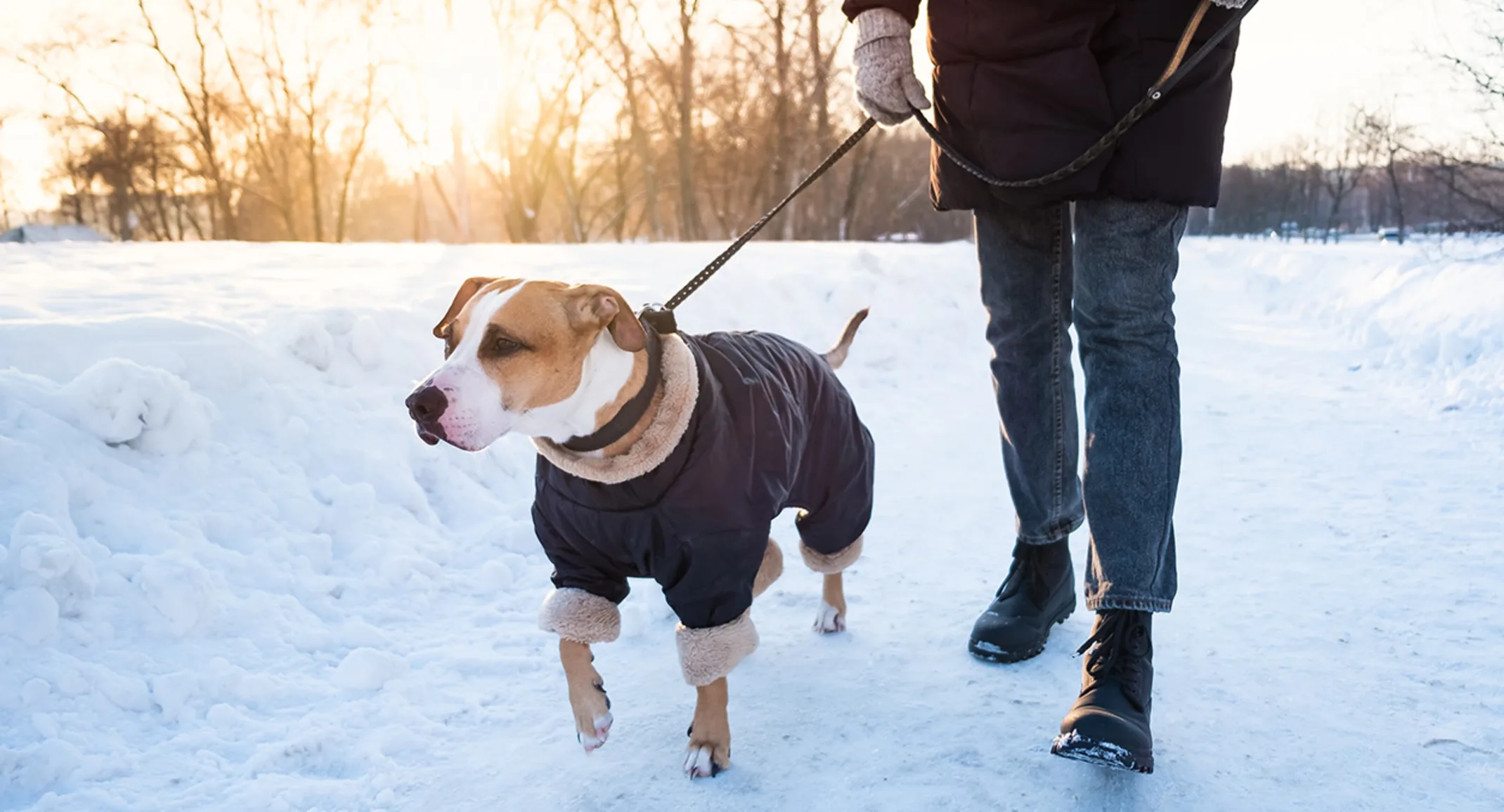6 Winter Pet Safety Tips
Tips and Tricks

Harsh winter weather poses hazards to people, but can be more difficult on our pets, who rely on us for their wellbeing. To keep your pet safe and warm when the temperatures drop, adjust your pet’s care and daily routines. Follow these six winter pet safety tips to protect your pet against cold winter weather hazards.
#1: Consider bundling up your pet
Pet jackets are more than a fashion statement—they provide an added layer of warmth that your pet may need during cold weather. When the temperatures drop below zero, dressing your pet in a jacket is beneficial, especially if they are going to be outside for longer than a bathroom break. Breeds with short, thin coats are particularly vulnerable to cold temperatures and may need added layers for warmth. In addition, before venturing out during the colder months, ensure you dress your small pet in a jacket, because these pets often have short legs—so close to the ground that their bodies are likely to touch snow and ice—making them especially vulnerable to the elements.
#2: Protect your pet’s paws
Deicers that melt snow and ice on walkways contain chemicals that can irritate your pet’s paw pads. If your pet steps in a deicer during a walk and licks the chemical off their paw pads, they can experience vomiting and diarrhea, leading to dehydration. If your pet ingests a large amount of deicing salt, their sodium level will become elevated, and they can experience tremors and seizures. To protect your pet from skin irritation or deicer ingestion, wipe their paws with a damp towel immediately after a walk to ensure their paw pads are clean. Consider trying pet booties, which provide a barrier for your pet’s paws. However, your four-legged friend may need time to adjust to walking in this paw-wear.
#3: Moisturize your pet’s skin
Your pet’s skin can become dry and cracked, because winter air has little humidity. Despite your pet being covered by a layer of fur, dry air can negatively affect their skin. Manage your pet’s cold-weather skin problems by following these tips:
Brush your pet regularly — Brushing stimulates the skin’s oil-producing glands and acts as a natural moisturizer. Without regular brushing, mats can develop, and can eventually tighten down to the skin, causing painful sores and infection underneath. Regular brushing keeps your pet’s coat and skin clean and moisturized throughout winter’s cold days.
Research topical moisturizers — A pet with excessively dry, flaky skin may benefit from a topical moisturizer. Ask your veterinarian to recommend a moisturizer for your pet’s specific skin needs.
Determine if your pet has allergies — While allergies aren’t a winter-specific problem, they can make your pet’s skin dry, flaky, and itchy. As a result of spending a lot of time in the house, pets who are sensitive to indoor allergens can experience increased signs. Your veterinarian can determine if allergies are causing your pet’s skin problems and recommend appropriate treatment, which may include:
Antihistamines
Essential fatty acids
Immunosuppressant medications
Monoclonal antibody therapy
#4: Keep your pet on a leash near frozen bodies of water
Frozen lakes and ponds pose many dangerous hazards to you and your pet. Keep your pet on a leash during walks to ensure they don’t run onto ice. Ice can cut your pet’s exposed skin, cause ice burn or frostbite, and lead to injuries as a result of slipping. A pet who falls through an ice-covered body of water has an immense hypothermia, organ damage, or drowning risk. If your pet falls through ice, do not attempt to rescue them. You won’t be in a position to help them if you fall through the ice too. If you can’t reach your pet from shore, call 9-1-1, or seek help.
#5: Keep antifreeze out of your pet’s reach
Antifreeze is a common vehicle and household chemical used to prevent freezing temperatures’ damage. However, the active ingredient—ethylene glycol—is extremely toxic to humans and their pets. Ethylene glycol has a sweet flavor that your pet may not be able to resist, and ingesting only a small amount of this chemical can be deadly. Immediately wipe up any antifreeze spills, and store the unused portion securely out of your pet’s reach. Antifreeze poisoning signs include:
Nausea and vomiting
Diarrhea
Wobbly or uncoordinated movement
Disorientation
Increased heart rate
Weakness
Tremors
Fainting
Low body temperature
Contact your veterinarian immediately if you observe your pet ingesting antifreeze or suspect they may have licked some off the ground.
#6: Do not leave your pet unattended in a parked vehicle
You are likely aware of the dangers of leaving a pet unattended in a parked vehicle during the hot summer months. However, winter can be just as dangerous. Vehicles are not well-insulated and will not protect your pet from frigid outdoor temperatures. Left alone in a cold car for too long, your pet is at risk of developing frostbite or hypothermia, which can lead to cardiac and respiratory failure, brain damage, coma, and—in some cases—death. If you’re running errands, leave your pet at home where they will stay safe and warm.
Following these tips can help you keep your pet safe during winter’s harsh weather, but keep in mind that unexpected illnesses and injuries can happen any time of year. If your pet experiences a winter emergency, use this locator tool to find a veterinary practice near you.
